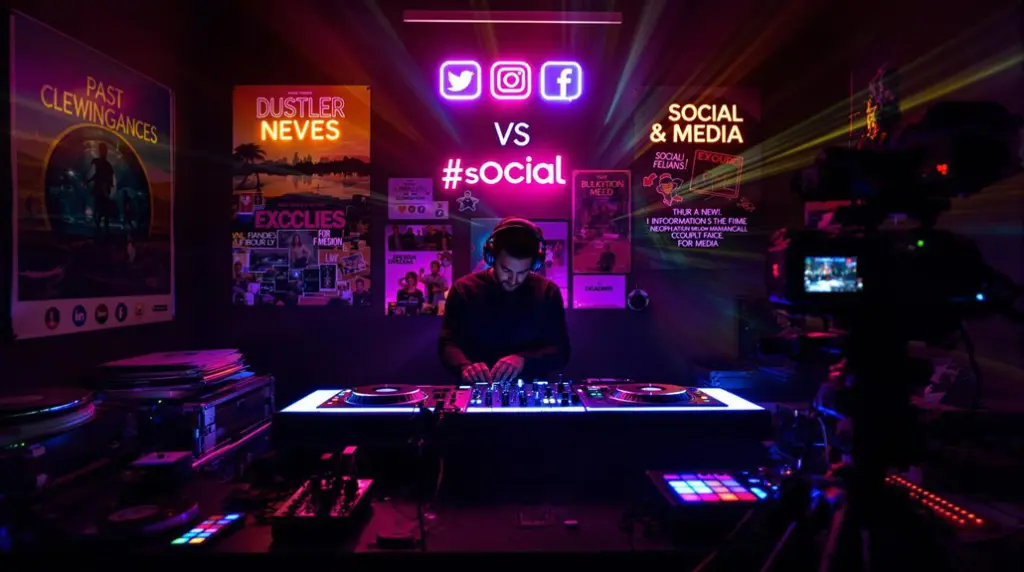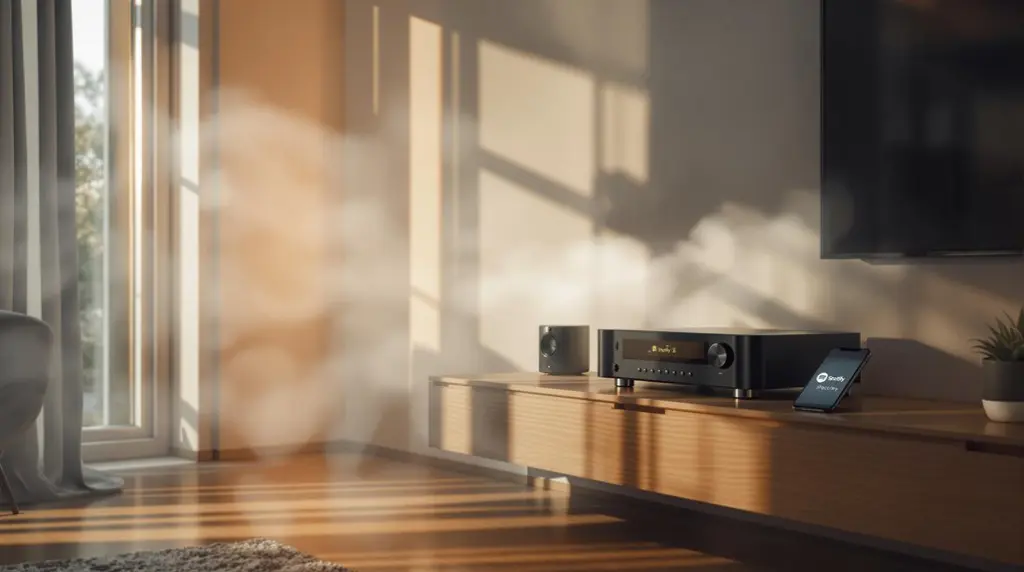Mastering dubstep, you’ll need to dive deep into its bass-heavy sounds and learn effective DJing techniques. Start by selecting a high-quality DJ controller that meshes well with intuitive DJ software for seamless performance. Don’t skimp on a quality audio interface and headphones; they’re essential for crystal-clear sound and accurate track cueing. Explore and integrate diverse dubstep tracks, focusing on pioneers like Skream and Benga to understand genre standards. Practicing your sets rigorously can greatly enhance your skills. Layer effects creatively and target those massive bass drops to energize your audience. Every session brings you closer to mastering the captivating art of dubstep DJing.
Key Takeaways
- Start by learning from dubstep pioneers like Skream and Benga to understand genre fundamentals.
- Invest in a quality DJ controller and headphones for precise mixing and sound control.
- Practice using effects creatively to enhance transitions and build dynamic sets.
- Develop your unique style by experimenting with bass drops and mixing techniques.
- Record your DJ sets to analyze and improve your skills continuously.
Understanding Dubstep Basics
To truly understand dubstep, you must immerse yourself in its roots in South London during the late 1990s, where it emerged with its distinct, bass-heavy sound. Dubstep’s origins are filled with the gritty textures of urban life, reflecting a culture interwoven with electronic music experimentation. The pioneers, like Skream, Benga, and Coki, crafted tracks that would define the essence of dubstep, using innovative sound design techniques that emphasized the depth and power of the bass.
Dubstep history shows that it isn’t just about the music; it’s about how the sound interacts with the listener. The genre’s hallmark includes syncopated rhythms and sparse arrangements that focus intensely on the low end of the spectrum. Sub-bass frequencies drive the narrative, while half-time drum patterns lay a foundation that allows for dynamic shifts and aggressive sound manipulation. This is where understanding sound design techniques becomes essential. Techniques like wobble bass, a method involving modulating basslines with low-frequency oscillators, create that characteristic pulsating effect that has captivated audiences worldwide.
Essential DJ Equipment
As you begin your DJing journey, choosing the right DJ controller is crucial; it’s the heart of your setup, seamlessly integrating with software to give you complete control over your mixes.
You’ll also need a sturdy audio interface to guarantee crisp, clear sound output, vital for both live performances and studio sessions.
Don’t overlook the importance of high-quality headphones—they’re your ally for precise track cueing and mixing, especially in noisy environments.
Choosing Your DJ Controller
Selecting the right DJ controller often marks the first essential step in mastering the art of DJing, as these devices provide direct interaction with your music through an array of tactile controls. When hunting for your ideal controller, consider both controller customization options and software compatibility considerations.
- Controller Customization Options: Look for a controller that allows you to map its buttons, knobs, and faders to your specific DJing style and needs.
- Software Compatibility: Make sure the controller is compatible with the DJ software you’re most comfortable using or intend to learn.
- Feature Set: Decide if you need advanced features like multiple decks, sample pads, or loop controls based on your DJing aspirations.
Choose wisely, as the right controller can dramatically influence your DJing flair and efficiency.
Essential Audio Interfaces
Understanding the role of audio interfaces in DJing is essential, as they bridge your equipment and computer for seamless sound control and recording. When making your audio interface selection, consider budget options that don’t compromise on quality. Look for interfaces with multiple inputs and outputs to connect all your gear, and make sure they include robust preamps for clear sound amplification.
It’s important to understand latency and buffer sizes, as these affect how quickly your music responds during live performances. Lower latency means faster response times, important for keeping your mixes tight and professional. Choose interfaces with adjustable buffer sizes to balance between minimal latency and maximum audio quality, especially during complex live sets. This knowledge empowers you to make informed decisions for excellent performance setups.
Quality Headphones Selection
To ensure accuracy in your mixes, you’ll need high-quality headphones that offer both excellent sound isolation and detailed audio reproduction. When choosing your DJ headphones, soundstage clarity is essential—it lets you discern each layer of the track with precision. Additionally, noise cancellation technology is a necessity to keep external noises at bay, ensuring that every beat and note is heard without interference.
Consider these key features:
- Wide frequency response: Captures every nuance of the music.
- Closed-back design: Offers excellent isolation in noisy environments.
- Swiveling ear cups: Facilitates easy one-ear monitoring during live sets.
Investing in the right headphones will enhance your DJing experience by providing the sonic accuracy and comfort needed for long mixing sessions.
Fundamental Mixing Techniques
As you step into the world of foundational mixing techniques, mastering the essentials of beat matching is your first step toward seamless blending.
You’ll need to fine-tune your EQ adjustments to guarantee each track blends perfectly without muddying the sound.
Lastly, mastering blending effects will empower you to add that professional touch and keep your audience engaged.
Beat Matching Essentials
Mastering beatmatching, the art of aligning two tracks’ tempos, is essential for ensuring your DJ set flows seamlessly without jarring tempo shifts. You’ll find that the precision of beatmatching can make or break the energy on the dance floor. Here are some key points to keep in mind:
- Tempo synchronization tips: Always start by identifying the BPM of both tracks.
- Beat matching troubleshooting: If tracks drift apart, subtly adjust the pitch fader.
- Advanced beatmatching techniques: Practice using sync to understand automatic matching, then challenge yourself to do it manually.
Explore beatmatching software options that can help you hone your skills. This blend of technology and technique will enhance your mixes, making them feel smooth and professionally crafted.
EQ Adjustment Tips
Have you ever wondered how professional DJs achieve such crisp and clear soundscapes in their mixes? It’s all about mastering EQ adjustments.
When mixing vocals, cutting specific mid-range frequencies can prevent them from clashing with other instruments, allowing the singer’s voice to shine through with clarity.
Similarly, using high-pass filters on non-bass elements eliminates muddy lows, essential for creating atmosphere that feels both spacious and precise.
Don’t overlook the power of low-pass filters to soften overly bright cymbals or hi-hats, enhancing the overall smoothness of your mix.
Transition Effects Mastery
To truly captivate your audience, you’ll need to master the art of blending effects, skillfully merging tracks with techniques like filters, echoes, flangers, and phasers. As you dive deeper into dubstep DJing, integrating advanced scratching techniques and mixing with vinyl can enhance your live performances. These skills not only boost your technical prowess but also inject a unique flair into your sets.
Here are key points to focus on:
- Timing and rhythm: Sync effects with the natural flow of the music.
- Experimentation: Mix different effects to discover unique soundscapes.
- Audience engagement: Use dynamic changes to keep the crowd energized.
Mastering Beat Matching
You’ll need to align the tempos of two tracks precisely to master beatmatching, a technique essential for seamless DJ blending. By mastering tempo synchronization and beat alignment, you’re guaranteeing each changeover is undetectable to the crowd, maintaining the energy and flow of your set. The tools at your disposal, such as pitch faders and tempo controls, are your best friends here. Adjusting these controls allows you to match the beats per minute (BPM) of your tracks, creating perfect harmony on the dance floor.
Mastering this skill requires rhythmic precision and a keen ear. Listen closely to ensure the beats of both tracks are perfectly in sync, achieving what DJs call track cohesion. This is not just about keeping your audience dancing, but also about respecting the art form that DJ Francis Grasso revolutionized back in 1969.
Here’s a quick reference to get you started:
| Step | Tool | Purpose |
|---|---|---|
| 1. Identify | BPM Counter | Measure track speeds |
| 2. Adjust | Pitch Faders | Align track tempos |
| 3. Listen | Headphones | Check rhythmic alignment |
Embark on this journey with patience and passion. Each mix you seamlessly blend will not only boost your confidence but also your standing as a skilled DJ.
Utilizing Effects Creatively
Maximize the full potential of your DJ sets by creatively utilizing effects like filters, delays, and reverbs to add depth and atmosphere to your dubstep mixes. When you’re spinning tracks, consider experimenting with different effect parameters. Adjusting the wet/dry mix or feedback settings can dramatically alter the texture and sound of your mix, providing a fresh and unique listening experience.
Exploring modulation effects, such as flangers and phasers, is essential. These can add an intriguing movement and dynamic to your tracks, especially when layered thoughtfully with other effects. Creative delay techniques, too, are important tools in your arsenal. They can echo beats in a mesmerizing pattern that captivates the dance floor, creating a palpable tension before a change.
Consider these strategies to enhance your mixes:
- Layer multiple effects to craft a richer, more complex sound.
- Use effects in adjustments to smooth changes and ramp up excitement.
- Manipulate effect parameters in real-time to keep your set dynamic and responsive.
Crafting Perfect Bass Drops
Crafting the perfect bass drop in your dubstep tracks involves mastering the art of heavy sidechain compression to deliver that ground-shaking impact. This technique allows the kick to punch through by temporarily reducing the volume of the bass, creating a dynamic interplay that emphasizes the rhythm and power of your drop.
To enhance your bass design, experiment with different distortion techniques. Adding a bit of grit and crunch to your bass lines not only intensifies their presence but also adds a raw, aggressive texture that’s vital for enthralling dubstep drops. Layering multiple bass elements is another key strategy. Combine sub bass with mid-range basses to build a fuller, more immersive sound. This layering not only enriches the texture but also reinforces the sonic impact.
Don’t overlook the importance of sub bass production. A solid sub bass foundation ensures that your drops hit with maximum force, resonating deeply with your audience. Additionally, integrating creative rhythm and unique percussion elements can greatly enhance your drop dynamics, making each bass drop not just heard, but felt. Remember, in dubstep, the power of your bass drop defines the energy of the track.
Building a Dubstep Library
Constructing your own dubstep library commences with comprehending its roots and appreciating the genre’s key influences. You’ll need to immerse yourself deeply into the works of pioneers like Skream, Benga, and Rusko, whose tracks encapsulate the quintessence of early dubstep. Their music, characterized by heavy basslines and syncopated rhythms, not only defines the classic sound but also serves as a fundamental layer in your collection.
When curating your library, focus on a diverse dubstep track selection that includes both foundational tunes and innovative subgenres like brostep and riddim. This variety ensures you’re well-equipped for any set, allowing you to seamlessly adapt to the crowd’s vibe.
Consider these genre blending techniques to enrich your library:
- Incorporate Future Bass: For a melodic contrast to traditional dubstep’s grit.
- Integrate Dark Atmospheric Vibes: Enhance your sets with moody, immersive sounds.
- Explore Labels: Delve into releases from influential labels like Deep Medi Musik and Tempa to discover tracks that resonate with true dubstep ethos.
Building a versatile and dynamic dubstep library isn’t just about collecting tracks—it’s about embracing the culture and continuous evolution of the genre.
Practicing Your DJ Sets
To hone your DJ skills, consistently practice your sets, experimenting with various mixing techniques and shifts to enhance your performance. Focus on creating setlists that are dynamic and engaging. This means not only selecting tracks that flow well but also thinking about the energy levels and the emotional journey you want your audience to experience. Improving track selection is vital; dive deep into your music library and explore different genres that can complement your dubstep base, ensuring your sets are unique and memorable.
Record each session and listen back critically. Identify parts where shifts are smooth and where they could use some refinement. This continuous feedback loop is essential for your growth. Additionally, setting specific goals for each practice can dramatically improve your efficiency. For instance, one session could focus on mastering tempo adjustments, while another might be dedicated to perfecting your cue points.
Launching Your DJ Career
As you begin your DJ career, establishing a strong online presence is essential for attracting attention and building a following. Start by creating a professional website and active social media profiles where you can engage directly with fans. Platforms like SoundCloud, Mixcloud, and YouTube are invaluable for showcasing your mixes. These channels not only enhance your visibility but also serve as critical tools in your marketing strategies.
Networking plays a pivotal role in your journey. Connect with other DJs, producers, and industry insiders. These relationships can lead to collaborations and gigs that might otherwise be out of reach. Remember:
- Your network is your net worth.
- Every connection counts.
- Mutual support can propel your career forward.
Crafting a compelling DJ bio is another important step. Highlight your unique style, influences, and any notable performances. This bio should reflect your personality and professionalism, enticing promoters and potential collaborators.
Lastly, always uphold impeccable performance etiquette. This means being punctual, prepared, and respectful to both venue staff and your audience. These practices not only enhance your professional image but also increase the likelihood of being rebooked, helping you secure a sustainable career in the competitive world of DJing.
Frequently Asked Questions
What Should a Beginner DJ Learn?
You should start by mastering beat matching and understanding equipment setup. These foundational skills are essential for your growth and confidence as a DJ, enabling dynamic, seamless performances that captivate your audience.
What Is the Easiest Music to Dj?
The easiest music to DJ often involves house or pop due to their steady beats and predictable structures, simplifying beat matching and playlist selection. Start with these to hone your skills effectively.
How Do I Start Mixing Dubstep?
To start mixing dubstep, you’ll need to master beat matching and explore sound design. Focus on syncing those heavy basslines at around 140 BPM and experiment with effects to enhance your tracks.
Can I Learn to DJ on My Own?
Yes, you can definitely learn to DJ on your own. Focus on equipment selection and establish consistent practice routines. With dedication, you’ll develop the skills needed to excel in DJing independently.




